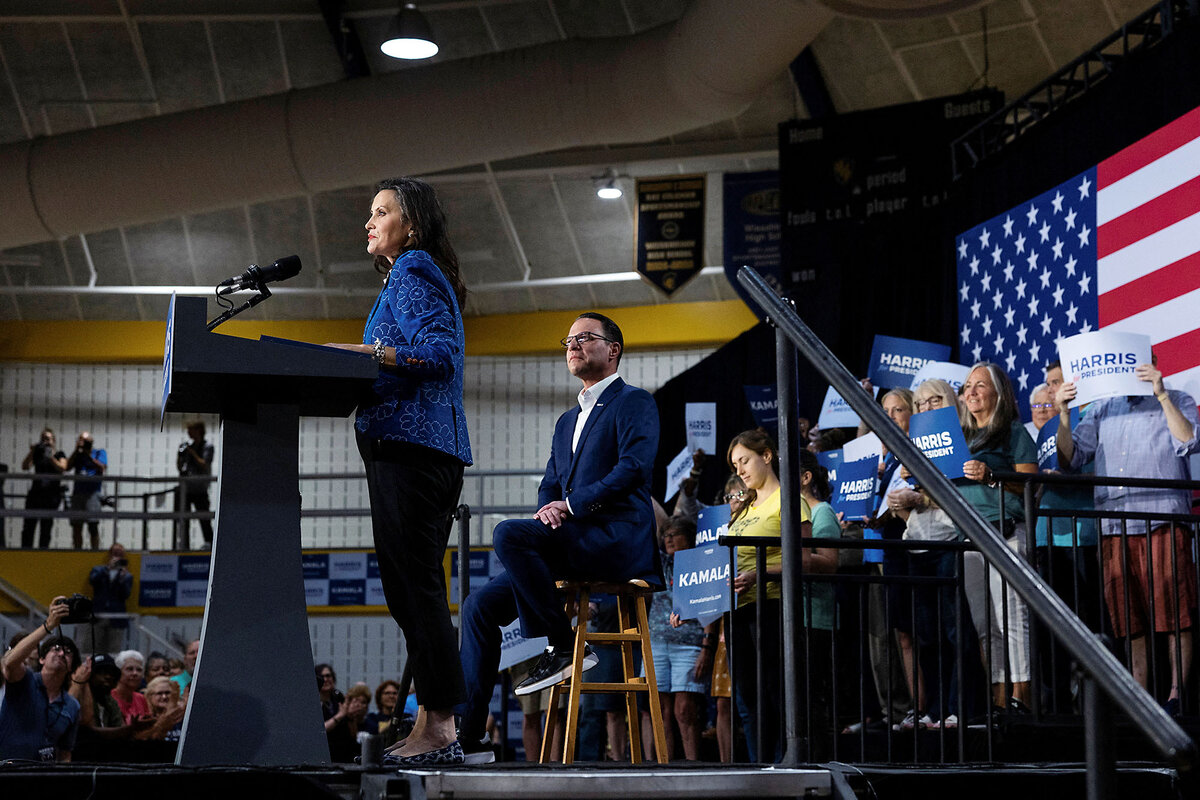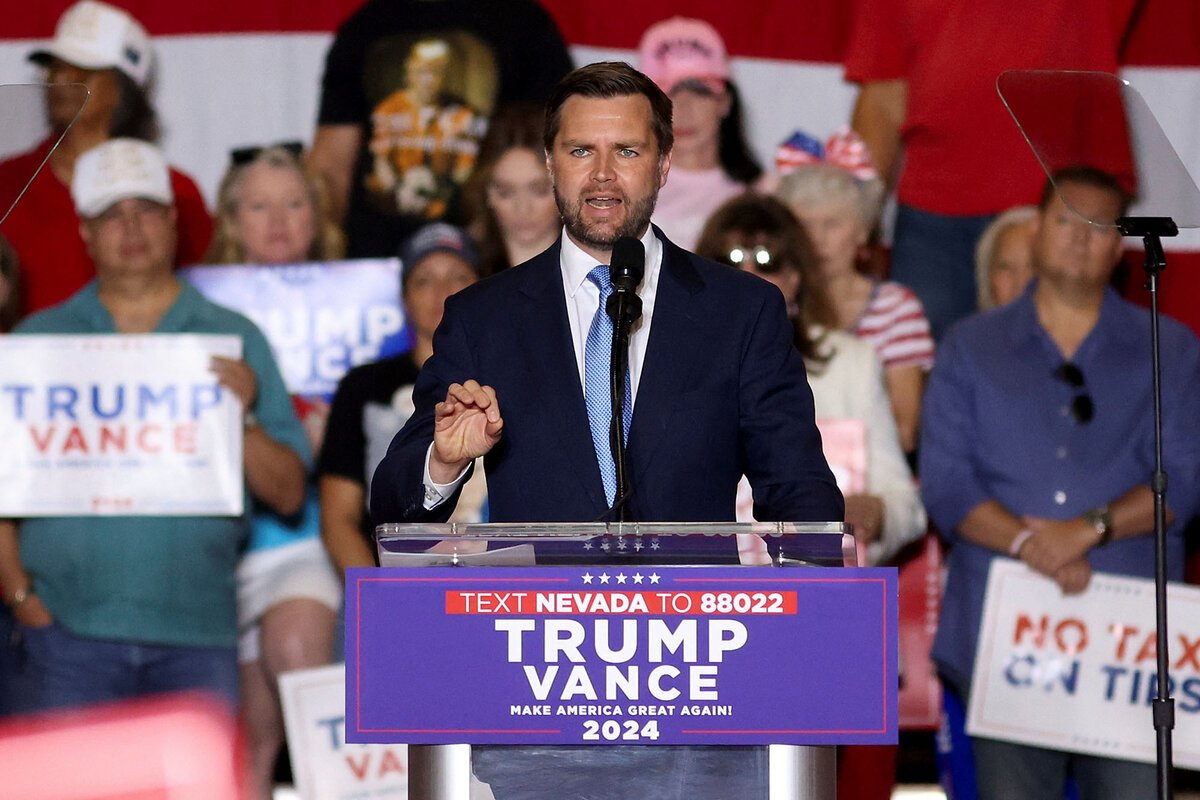How Harris’ candidacy is shifting the electoral map
Loading...
By switching to Vice President Kamala Harris as their presumptive nominee, Democrats have gotten a jolt of momentum and a flood of campaign donations.
They may also have shifted the political map.
When President Joe Biden still topped the ticket, his team was looking at a narrowing path to 270 Electoral College votes, with the entire campaign likely hinging on Wisconsin, Michigan, and Pennsylvania – “blue wall” states with large populations of older, white, working-class voters.
Why We Wrote This
Kamala Harris is polling better than Joe Biden among young voters, Black and Hispanic voters, and suburbanites. The trade-off: She’s doing slightly worse among white voters without college degrees. All this may affect the electoral map.
But Ms. Harris, a multiracial woman two decades younger than Mr. Biden, is demonstrating far greater appeal among young, Black, and Hispanic voters, according to recent polling. And that’s putting fast-growing, diverse states like Nevada, Arizona, and Georgia – where Mr. Biden eked out victories in 2020 but had trailed former President Donald Trump throughout this cycle – squarely back in play. Even North Carolina, which narrowly backed Mr. Trump last time around, now looks like a target.
While Democrats are hardly discounting the importance of the electoral vote-rich Rust Belt, it’s clear Ms. Harris is pursuing an equally vigorous Sun Belt strategy.
“Everything has changed,” says Jeremy Hughes, a Republican strategist who was Pacific regional political director for the 2020 Trump campaign. Up until a few weeks ago, Mr. Hughes had been so confident of a Trump victory in Nevada, for example, that he regarded that state as essentially off the table. Not anymore. “[Nevada] could decide who wins the election.”
The same goes for Georgia. “We’ve had tons of people reach out to figure out how they can get involved, where they can donate,” says Melissa Clink, a vice chair of the Democratic Party in Forsyth County, where more than 300 people showed up Sunday at an event where Kentucky Gov. Andy Beshear was campaigning on Ms. Harris’ behalf. “Locally, the energy has been electric.”
For her second campaign rally since taking over the ticket, Ms. Harris traveled to Atlanta Tuesday evening, where she spoke to a crowd of around 10,000 attendees in Georgia State University’s basketball arena, after appearances from rappers Quavo and Megan Thee Stallion.
“The path to the White House runs right through this state,” Ms. Harris said at the start of her speech. “You all helped us win in 2020, and we’re going to do it again in 2024.”
Seven battleground states
The shifting map doesn’t mean there’s suddenly a new list of battlegrounds. Democratic and Republican strategists alike agree that the same seven states that decided the election in 2020 – where either Mr. Biden or Mr. Trump won by 3 percentage points or less – are probably going to decide this one.
If anything, the seven top battlegrounds appear more set now than before Ms. Harris became the presumptive nominee, when Republicans had begun speculating about flipping blue states like Virginia, Minnesota, and New Mexico, as President Biden’s candidacy faltered. Those dreams of a GOP landslide now look far less likely.
A new Bloomberg/Morning Consult poll released Tuesday shows Ms. Harris has improved on Mr. Biden’s position in all seven swing states. In Nevada and Arizona, where Mr. Biden had been trailing Mr. Trump, Ms. Harris now leads by 2 points. Georgia, where Mr. Trump had also held a lead, is now tied. All of the states remain close, however, with only Michigan showing a Harris lead outside the margin of error.
The current boost for Democrats may reflect a “Harris Honeymoon,” as Trump pollster Tony Fabrizio argues. It’s possible the map could narrow as Democratic enthusiasm wears off and Republican attacks take hold.
But a closer look at recent polls’ cross tabs, or survey data tables, suggests that there is a voter trade-off taking place – one that, for now, appears to be benefiting Democrats.
In New York Times/Siena surveys looking at Mr. Biden’s candidacy in June and then Ms. Harris’ candidacy in July, Ms. Harris improved on Mr. Biden by 10 points among voters under 30, 10 points among Black voters, and 12 points among Hispanic voters. She also gained 8 points among suburban voters. At the same time, Ms. Harris dropped among white voters without college degrees by 2 points.
These types of shifts have an impact on the electoral map. Among the top battlegrounds, Georgia and North Carolina have among the country’s highest shares of Black voters (about one-third and one-quarter of the eligible voting population, respectively), while Arizona and Nevada have some of the highest shares of Latino voters, at 25 and 22%. Pennsylvania, Michigan, and Wisconsin, on the other hand, have higher shares of white voters without college degrees, as well as significant suburban populations.
In 2016, Democratic nominee Hillary Clinton lost the Electoral College after Pennsylvania, Michigan, and Wisconsin, which had backed Democrats in presidential elections for decades, voted for Donald Trump. In 2020, Mr. Biden was able to “claw back” enough working-class white voters in to recapture those states, says Kyle Kondik, managing editor of Sabato’s Crystal Ball, a nonpartisan political analysis and electoral projections newsletter run by the University of Virginia’s Center for Politics.
Yet Mr. Biden’s success in these states, along with Arizona, Nevada, and Georgia, was also buoyed by inroads in the suburbs – a trend that seems to be increasing with Ms. Harris at the top of the ticket. While Democrats may not be able to reassemble the same coalition of voters who put Barack Obama in the White House, they may not need to.
“Turning back the clock to the Obama coalition doesn’t seem realistic because Democrats have lost working-class white voters who aren’t coming back,” says Mr. Kondik. “2024 is basically the third iteration of 2016 and 2020. I’m expecting similar voting patterns, maybe with changes at the margins.”
The “blue wall”
While Ms. Harris may do well in the Sun Belt, Mr. Kondik says he’d be “very surprised” if she ends up with an Electoral College victory that doesn’t include Michigan, Pennsylvania, or Wisconsin – in part because of simple math.
The three Rust Belt swing states have 44 electoral votes between them, while the three Sun Belt states (not including North Carolina) have 33. If Ms. Harris wins Nevada, Arizona, Georgia, and Wisconsin, but loses Michigan and Pennsylvania, she wouldn’t get to the winning number of 270 Electoral College votes. The election would be a 269-269 tie.
“In terms of how far our dollar goes to winning this election, our answer is unequivocally Michigan, Wisconsin, and Pennsylvania,” says Pat Dennis, president of American Bridge 21st Century, a Democrat-aligned super PAC that announced a $140 million paid media program in those three states earlier this year. The week Mr. Biden dropped out of the race and endorsed Ms. Harris, Mr. Dennis’ group announced a $20 million ad buy featuring voters from the same three states. “There is no change in the Electoral College map that is conceivable to me that we would shift focus away from these states.”
Still, Mr. Dennis and other Democrats make the point that Ms. Harris’ competitive position in other swing states will help Democrats’ chances in November, even if those states ultimately end up voting for Mr. Trump, because it will force the Trump campaign to spend money there. Case in point: The Trump campaign on Wednesday was reportedly placing new ad spending in North Carolina, where Mr. Trump has been ahead in the polls, and where Ms. Harris has already begun running ads.
“If [Harris] can force Donald Trump to go defend Georgia, Arizona, Nevada, and North Carolina, that means far less resources get poured by the Trump campaign into the upper Midwest,” says Richard Czuba, a nonpartisan pollster in Michigan. “The best defense is a great offense. If she can run offense in those states, it certainly helps them win the northern wall.”
Within that “northern wall” of Michigan, Wisconsin, and Pennsylvania, Mr. Czuba’s own polling suggests that Ms. Harris has already improved on Mr. Biden’s numbers in Michigan. In January, Mr. Czuba’s poll had Mr. Biden trailing Mr. Trump by 8 points there whereas his poll from last week found Ms. Harris and Mr. Trump tied. But those topline numbers weren’t Mr. Czuba’s biggest takeaway. He says he was “stunned” when he looked at the poll’s “motivation to vote” figures.
“Kamala Harris has jacked the motivation of Democratic voters through the roof in Michigan,” says Mr. Czuba, specifically young voters, Black voters, and longtime Democrats. The numbers look similar to what Mr. Czuba saw before the 2020 and 2022 elections, when Democrats performed well statewide.
After Ms. Harris’ rally in Atlanta, Ms. Clink texted her big takeaway: “Georgia isn’t going back.”









